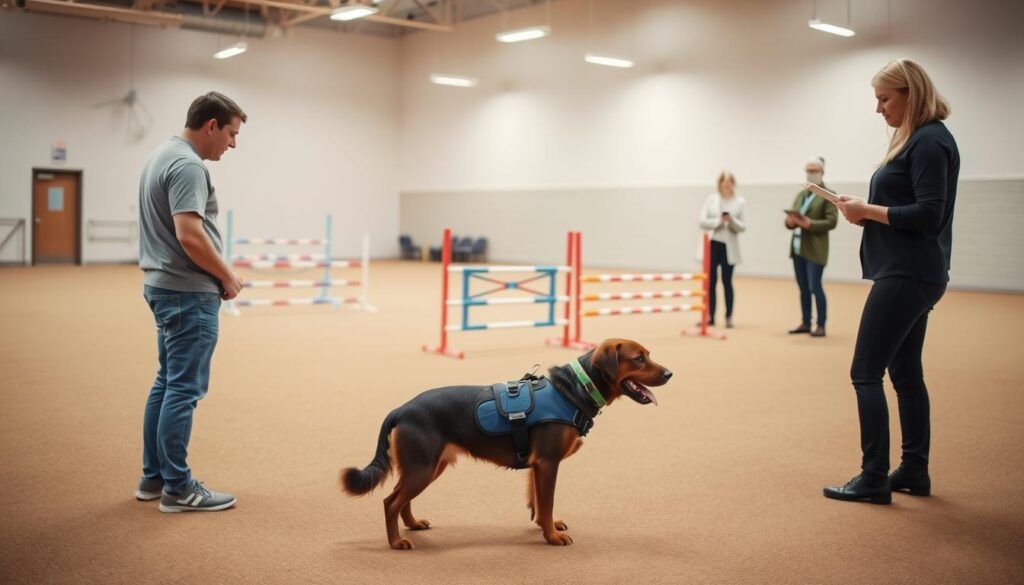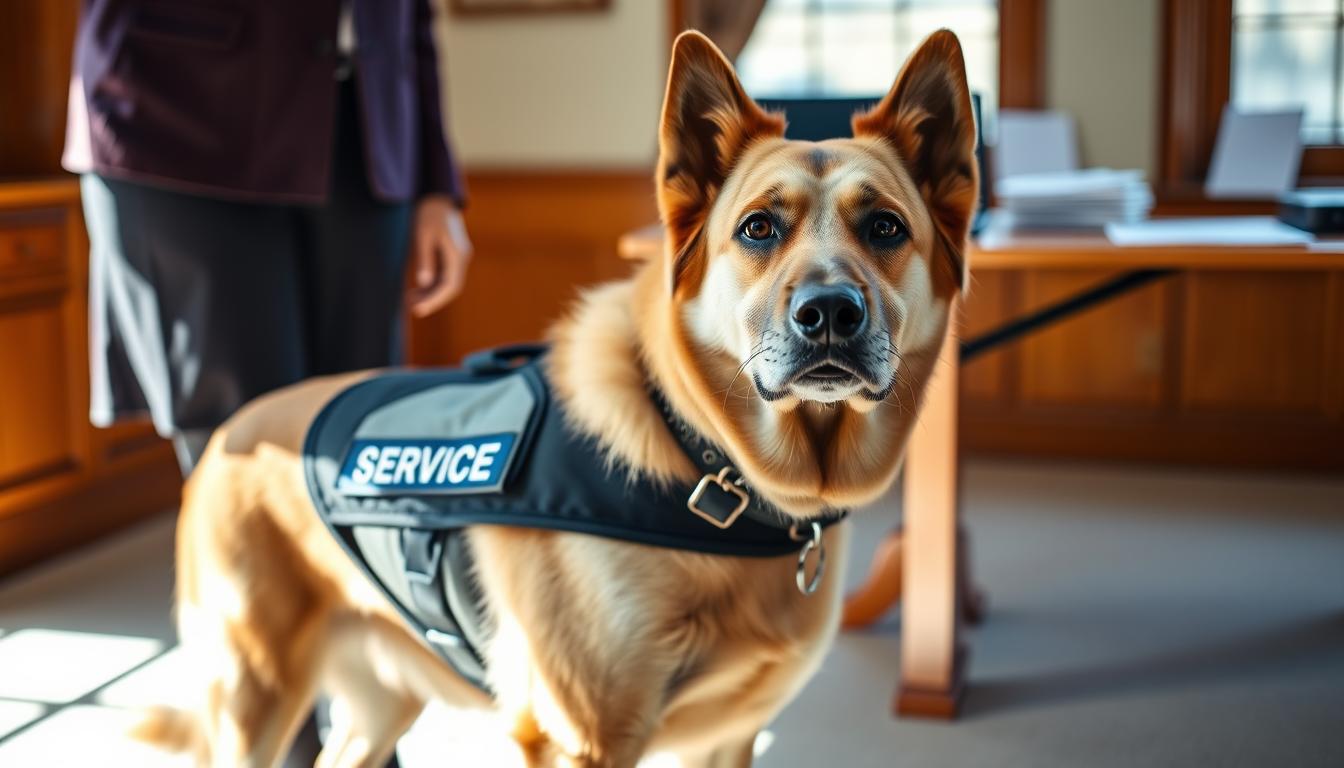How Do I Get a Service Dog Certification: 5 Steps to Success
Table of Contents
How Do I Get a Service Dog Certification
Living with a disability can be tough. But, a service dog can change your life in amazing ways. Getting a service dog certification is more than just filling out forms. It’s about finding a true friend who helps you be independent and feel supported.
When you start the service dog certification process, you’ll see it’s a special path. It connects people with amazing dogs. These dogs are not just pets. They are trained to help you live better.
The Americans with Disabilities Act (ADA) has rules about service dogs. They are trained to help with disabilities. Knowing these rules is key when you’re getting a service dog certification.
Key Takeaways
- Service dogs provide critical assistance for individuals with disabilities
- Certification involves comprehensive training and legal documentation
- ADA defines specific standards for service dog qualifications
- Each service dog is uniquely trained to support individual needs
- The certification process requires professional evaluation and documentation
What is a Service Dog Certification?
Service dog certification can be tricky to understand. It’s not required by law, but it helps handlers and their dogs move through public places easily. Service dogs are vital for people with disabilities, doing tasks that make life better.
A service dog is more than a pet. They are trained to help with physical, mental, and emotional issues. The main goal of service dog certification is to show the dog can do specific tasks for its handler’s disability.
Definition of Service Dogs
Service dogs are trained animals that help people with disabilities do everyday tasks. They are different from other animals because of their training:
- They do specific tasks for their handler’s disability
- They get special training
- They directly help their handler
Importance of Certification
Even though the ADA doesn’t need a formal certification, it can make things easier. A real service dog certification:
- Shows the dog’s training and skills
- Protects the handler’s rights
- Helps avoid misunderstandings
Differentiating Service Dogs from Other Assistance Animals
Not all animals that help are service dogs. Here’s what sets them apart:
- Service dogs are trained for specific tasks
- Emotional support animals offer comfort but don’t have special training
- Therapy dogs help in places like hospitals
The true value of a service dog lies in its ability to enhance independence and quality of life for individuals with disabilities.
Legal Framework Surrounding Service Dogs
Understanding the legal side of service dog certification can be tricky. It’s key for those who depend on service dogs every day. The laws help protect and guide service dog handlers in the U.S.
The Americans with Disabilities Act (ADA) is the main law for service dogs. It gives important protections to people with disabilities and their service animals.
ADA Overview
The ADA says service dogs are about their skills, not just a piece of paper. It includes:
- Service dogs must be trained for specific tasks related to a disability
- Dogs are covered by civil rights laws
- Public places must let service dogs in
State-Specific Regulations
Even though the ADA sets federal rules, states can have their own laws. These laws can be very different from one place to another.
“Understanding both federal and state regulations is essential for service dog handlers.” – Disability Rights Advocate
Rights and Responsibilities of Handlers
Service dog handlers have certain rights and duties:
- They must always control the service dog
- The dog must behave well in public
- They should have the right papers ready when asked
While no official “certification” is needed, proper training and papers can make things easier in public.
Qualifications for a Service Dog
Choosing a service dog is a big decision. It needs careful thought about the dog’s skills, personality, and training. Not every dog can be a service animal because it’s a tough job.
Service dogs help people with many disabilities. The right dog can change someone’s life by giving them help and freedom.
Types of Disabilities Supported
Service dogs help with many disabilities, including:
- Physical mobility impairments
- Visual and hearing disabilities
- Neurological conditions
- Psychiatric disorders
- Chronic medical conditions
Behavioral Requirements for Service Dogs
Service dogs need to be very well-behaved. They must:
- Stay focused and disciplined
- Be calm in public
- Quickly follow commands
- Not get easily distracted
- Act professionally everywhere
Training Standards and Best Practices
Service dog training is tough but important. Here’s what they learn:
| Training Category | Core Skills | Duration |
|---|---|---|
| Basic Obedience | Command response, leash control | 3-6 months |
| Task-Specific Training | Disability-related assistance skills | 6-12 months |
| Public Access Training | Behavior in crowded/stressful environments | 2-4 months |
| Socialization | Interaction with people and other animals | Ongoing |
Good service dog training makes sure these amazing animals can help a lot while acting professionally.
Steps to Getting a Service Dog
Getting a service dog certification needs careful planning and understanding. If you’re wondering how to get a service dog certification, this guide will help. It will show you the key steps to find the right support for your needs.
Getting a service dog involves important steps. First, you need to decide if a service dog is right for you. Think about your disability and lifestyle.
Assessing Your Service Dog Needs
Before starting the service dog certification process, think about what you need:
- Identify the specific tasks you need assistance with
- Determine your mobility and physical limitations
- Consider your living environment and daily routine
- Consult with healthcare professionals about potential benefits
Finding a Reputable Training Program
Finding the right training program is key for successful service dog certification. Look for programs with a good track record and thorough training.
| Program Criteria | What to Look For |
|---|---|
| Certification Standards | Accredited training curriculum |
| Training Duration | Minimum 18-24 months of specialized training |
| Trainer Credentials | Professional certifications in service dog training |
Choosing the Right Breed
Not all dogs are good for service work. Temperament, size, and physical capabilities are important. Popular breeds like Labrador Retrievers, Golden Retrievers, and German Shepherds are smart and easy to train.
Remember, getting a service dog is a big commitment. Do your research, talk to experts, and make sure you’re ready for the responsibilities of a service dog partnership.
Training Your Service Dog
Training a service dog is a big job. It turns a smart dog into a helpful partner. This process needs lots of training, patience, and special skills.
To get a real service dog certification, start with obedience and behavior basics. Your dog must be very disciplined and quick to follow commands in different places.
Fundamental Training Techniques
The main part of service dog training is learning key skills:
- Basic obedience commands
- Public behavior management
- Impulse control
- Distraction resistance
Specialized Task Training
After basic training, service dogs learn special skills for different needs. These might include:
- Medical alert responses
- Mobility assistance
- Psychiatric support tasks
- Navigation assistance
Training Duration and Timeline
Service dog training takes a lot of time:
| Training Stage | Estimated Duration | Focus Area |
|---|---|---|
| Basic Obedience | 3-6 months | Core commands and behavior |
| Specialized Task Training | 6-12 months | Disability-specific skills |
| Public Access Training | 2-4 months | Environment adaptation |
How well you and your dog work together is key. Getting help from experts makes sure your dog is ready for the job.
Testing Your Service Dog’s Skills
The service dog certification process is thorough. It checks if your dog meets high standards of performance and reliability. Professional trainers are key in checking if a service dog is ready to help people with disabilities.

Your service dog will face tough tests during the certification readiness assessment. These tests check their training and skills. They look at more than just basic obedience. They see if the dog can do special tasks well and consistently.
Professional Trainer Evaluation
A certified trainer will deeply assess your service dog’s skills. The evaluation includes:
- Temperament assessment
- Task-specific performance
- Public access behavior
- Distraction resistance
- Handler interaction
Mock Scenarios and Real-Life Situations
Trainers use tough scenarios to test the dog’s skills. These scenarios are like real-world situations. They might include:
- Navigating crowded spaces
- Responding to medical alerts
- Maintaining focus under stress
- Performing specific assistance tasks
Certification Readiness Assessment
The last step is a detailed review of the dog’s performance. Trainers look for consistent, reliable, and appropriate responses in different situations. They make sure the dog can really help its handler.
A true service dog is not just a pet, but a highly trained professional companion dedicated to improving their handler’s quality of life.
Where to Obtain Service Dog Certification
Finding the right path for service dog certification can be tricky. It’s important to research and understand your options. Whether you’re looking to get a service dog certification or want to explore online options, there are many reliable sources to consider.
Choosing the right certification is key. It ensures your service dog meets professional and legal standards.
National Organizations for Certification
Many national organizations offer top-notch service dog certification programs:
- Assistance Dogs International (ADI)
- International Association of Assistance Dog Partners (IAADP)
- Service Dogs of America
Local Certification Resources
Local options offer personalized training and certification. Here are some to consider:
- Professional dog training facilities
- Specialized service dog training centers
- Local disability support organizations
Online Certification Resources
Be careful with online service dog certifications. Not all online certifications are legitimate. Always check:
- Accreditation status
- Training curriculum
- Professional trainer credentials
| Certification Type | Pros | Cons |
|---|---|---|
| National Organizations | Comprehensive training | Higher cost |
| Local Training | Personalized approach | Limited availability |
| Online Certification | Convenient | Potential lack of legitimacy |
Your goal should always be to get the best training and support for your needs.
Documentation Needed for Certification
Getting your service dog certified can be tricky. The Americans with Disabilities Act (ADA) doesn’t require specific papers. But, many groups have their own rules for service dog owners.
To prepare your service dog’s papers, you’ll need a few important items. These show your dog’s skills and health.
Health and Vaccination Records
Your service dog’s health records are key for certification. You’ll need:
- Current vaccination records
- Veterinary health certificates
- Proof of regular medical check-ups
- Parasite prevention documentation
Proof of Training Completion
Service dog legal needs often include showing your dog’s training. You’ll need:
- Training program certificates
- Detailed training logs
- Professional trainer evaluations
- Task-specific training documentation
Owner and Handler Identification
Even though it’s not required by law, many programs ask for handler info:
- Government-issued identification
- Proof of disability (if applicable)
- Handler contact information
- Emergency contact details
Remember: The most important aspect of a service dog is its ability to perform specific tasks, not the paperwork.
Common Misconceptions About Service Dogs
Dealing with service dogs can be tough, especially with so much wrong information out there. It’s key to know what makes a service dog legit and what laws they follow. This is important for both the dogs’ owners and everyone else.

Many folks get the wrong idea about service dogs and their rights. Let’s debunk some common myths:
Myths vs. Reality
- Myth: Service dogs must wear special vests or identification
Reality: No, there’s no law that says they must wear vests. The only real way to know a service dog is by its behavior and training skills.
- Myth: Any dog can be a service dog
Reality: Service dogs get special training to help people with disabilities. It’s not just any dog.
- Myth: Service dogs and emotional support animals have the same rights
Reality: No, they don’t. Service dogs can go anywhere with their owners, but emotional support animals don’t have the same rights.
Understanding Public Access Rights
The Americans with Disabilities Act (ADA) sets rules for where service dogs can go. These dogs can be with their owners in many places, like:
- Restaurants
- Stores
- Public transportation
- Workplaces
Differentiating Service Dogs from Emotional Support Animals
Service dogs and emotional support animals are not the same. Service dogs are trained to help people with disabilities. Emotional support animals are there for comfort but don’t have the same training.
Legitimate service dog certification is about the dog’s skills, not about papers or accessories.
Knowing the difference helps make a better world for service dog owners and everyone else.
Cost Considerations for Service Dog Certification
Understanding the costs of service dog certification is key for those interested. Getting a service dog requires a big financial commitment. This goes beyond just the initial training costs.
Breakdown of Potential Expenses
Looking into service dog certification, you’ll find several main cost areas:
- Professional Training: $5,000 – $25,000
- Initial Service Dog Acquisition: $15,000 – $30,000
- Annual Healthcare Expenses: $500 – $2,000
- Specialized Equipment: $200 – $1,000
Financial Planning Strategies
Managing the cost of service dog certification is possible with good financial planning. Many groups help by offering financial aid to those with disabilities needing service dogs.
| Funding Source | Potential Coverage | Application Requirements |
|---|---|---|
| Disability Grants | Up to 50% of Training Costs | Medical Documentation |
| Veteran Support Programs | Full or Partial Funding | Military Service Verification |
| Non-Profit Organizations | Sliding Scale Assistance | Financial Need Assessment |
Long-Term Financial Commitment
It’s important to remember this is not a one-time expense. Ongoing costs include vet care, training, nutrition, and equipment needs.
“A service dog is a lifelong companion and professional partner requiring sustained financial investment.”
Good financial planning and looking into different funding options can help manage the cost of a service dog.
Ongoing Responsibilities for Service Dog Handlers
Being a service dog handler is a big commitment. It’s not just about the initial training and getting certified. You must always work to keep your dog’s skills sharp, their health good, and how others see them positive.
The journey to keep your service dog certified is ongoing. You’ll need to learn and grow constantly. Your job is to make sure your service dog stays effective and ready for anything.
Recertification and Continuous Training
Keeping your service dog’s skills up is key. Experts say you should:
- Take regular skill refresher courses
- Practice with your dog every month
- Evaluate your dog’s performance yearly
- Change your training as your needs change
Maintaining Your Dog’s Health and Well-Being
Your service dog’s health affects how well they work. You should focus on:
- Seeing the vet regularly
- Feeding them a balanced diet
- Keeping them active
- Giving them mental breaks and rest
Community Responsibility and Advocacy
As a handler, you’re key in teaching people about service dogs. Your actions can help clear up misunderstandings and show the value of service dogs.
Every time you meet someone, you’re showing the world how important service dogs are. They help people with disabilities in big ways.
Your work goes beyond just helping yourself. By being a responsible handler, you help everyone understand and respect service dogs more.
Conclusion: Taking the Next Steps
Getting a service dog certification can seem tough, but knowing the steps helps. It starts with training and ends with a detailed evaluation. Your hard work will change your life and your dog’s role.
Assistance Dogs International (ADI) says to do your homework and get expert advice. Choosing the right breed and training are crucial. It’s not just about the papers; it’s about a deep bond that helps you.
Your Path Forward
Thinking about getting a service dog? It’s a big step with great rewards. Look for good training programs and support groups. Talk to experts and other handlers for advice.
Additional Support Resources
Groups like ADI and local support groups have lots of help. You can find trainers, vets, and advocates for your needs. With determination and planning, you’ll get through the process.
FAQ
What exactly is a service dog certification?
A service dog certification proves a dog’s training to help people with disabilities. It’s not required by law, but it shows your dog is trained to assist you.
Is online service dog certification legitimate?
Most online service dog certifications are not recognized by law. The ADA doesn’t require a certificate. What matters is if your dog can do specific tasks for your disability.
How much does service dog training and certification cost?
Service dog training can cost between ,000 to ,000. This includes the dog’s training, specific tasks, and ongoing care.
What legal rights do service dogs have?
Service dogs have rights under the ADA. They can go into places where pets usually can’t, like restaurants and stores. They must be well-behaved and under control.
What types of disabilities qualify for a service dog?
Service dogs help with many disabilities. This includes physical issues, vision or hearing problems, and conditions like PTSD and diabetes.
Do I need a doctor’s documentation for a service dog?
While not required, a doctor’s note can be helpful. It should explain your disability and how a service dog helps. Businesses can’t ask for too much medical info.
How long does it take to train a service dog?
Training a service dog takes 1-2 years. It includes basic obedience, task training, and learning to behave in public.
Can any breed be a service dog?
Any breed can be a service dog, but some are better suited. Breeds like Labradors and German Shepherds are popular because they’re smart and easy to train.
What’s the difference between a service dog and an emotional support animal?
Service dogs are trained to help with disabilities and have wide rights. Emotional support animals provide comfort but don’t have the same rights.
How do I start the process of getting a service dog?
First, talk to healthcare professionals about your needs. Look for reputable training programs and understand the costs. Decide if a service dog is right for you.
There are no reviews yet. Be the first one to write one.


